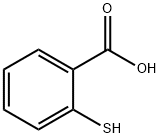Thioacetic acid
Synonym(s):TAA;Thiacetic acid;Thioacetic acid;TMA
- CAS NO.:507-09-5
- Empirical Formula: C2H4OS
- Molecular Weight: 76.12
- MDL number: MFCD00004853
- EINECS: 208-063-8
- SAFETY DATA SHEET (SDS)
- Update Date: 2025-09-25 17:15:13

What is Thioacetic acid?
Chemical properties
colourless fuming liquid with an unpleasant odour
Chemical properties
Pale yellow liquid; cooked brown and roasted meat aroma.
The Uses of Thioacetic acid
Thioacetic acid is a reagent for introduction of the thiol group into organic molecules. It is used as flavor & Fragrance Intermediates. It is used to manufacture captopril(antihypertension) and spironolac-tone (diuretic).
The Uses of Thioacetic acid
Chemical reagent, lachrymator.
What are the applications of Application
Thioacetic acid is a reagent for introduction of the thiol group into organic molecules.
Definition
ChEBI: A thioacetic acid that is acetic acid in which the oxygen atom of the hydroxy group has been replaced by a sulfur atom.
General Description
A clear,yellow liquid with a strong, unpleasant odor. May be toxic by ingestion, inhalation and skin absorption. Irritating to skin and eyes. Flash point near 50°F. Used to make other chemicals.
Air & Water Reactions
Highly flammable. Water soluble.
Reactivity Profile
Thioacetic acid is a thio organic acid. Organosulfides are incompatible with acids, diazo and azo compounds, halocarbons, isocyanates, aldehydes, alkali metals, nitrides, hydrides, and other strong reducing agents. Reactions with these materials generate heat and in many cases hydrogen gas. Many of these compounds may liberate hydrogen sulfide upon decomposition or reaction with an acid.
Hazard
Toxic by ingestion and inhalation; strong irritant to eyes and skin.
Health Hazard
May cause toxic effects if inhaled or absorbed through skin. Inhalation or contact with material may irritate or burn skin and eyes. Fire will produce irritating, corrosive and/or toxic gases. Vapors may cause dizziness or suffocation. Runoff from fire control or dilution water may cause pollution.
Fire Hazard
HIGHLY FLAMMABLE: Will be easily ignited by heat, sparks or flames. Vapors may form explosive mixtures with air. Vapors may travel to source of ignition and flash back. Most vapors are heavier than air. They will spread along ground and collect in low or confined areas (sewers, basements, tanks). Vapor explosion hazard indoors, outdoors or in sewers. Runoff to sewer may create fire or explosion hazard. Containers may explode when heated. Many liquids are lighter than water.
Flammability and Explosibility
Highly flammable
Safety Profile
Poison by intraperitoneal route. A very dangerous fire hazard when exposed to heat or flame. When heated to decomposition it emits toxic fumes of SOx. See also SULFIDES and MERCAPTANS.
Properties of Thioacetic acid
| Melting point: | -17 °C |
| Boiling point: | 97 °C |
| Density | 1.065 g/mL at 25 °C(lit.) |
| vapor pressure | 1 hPa (20 °C) |
| FEMA | 4210 | THIOACETIC ACID |
| refractive index | n |
| Flash point: | 52 °F |
| storage temp. | Store below +30°C. |
| solubility | 27g/l (slow decomposition) |
| form | Liquid |
| pka | 3.33(at 25℃) |
| color | Clear colorless to pale yellow |
| PH | 1.8 (100g/l, H2O, 20℃)Hydrolysis |
| Odor | at 0.01 % in propylene glycol. cooked roasted meaty burnt |
| Water Solubility | 27 g/L (15 ºC) (hydrolyse) |
| Merck | 14,9320 |
| JECFA Number | 1676 |
| BRN | 773684 |
| Dielectric constant | 13.0(20℃) |
| Stability: | Stable. Flammable. Incompatible with metals, strong oxidizing agents. |
| CAS DataBase Reference | 507-09-5(CAS DataBase Reference) |
| NIST Chemistry Reference | Ethanethioic acid(507-09-5) |
| EPA Substance Registry System | Ethanethioic acid (507-09-5) |
Safety information for Thioacetic acid
| Signal word | Danger |
| Pictogram(s) |
 Flame Flammables GHS02  Corrosion Corrosives GHS05  Skull and Crossbones Acute Toxicity GHS06 |
| GHS Hazard Statements |
H225:Flammable liquids H301:Acute toxicity,oral H317:Sensitisation, Skin H318:Serious eye damage/eye irritation H332:Acute toxicity,inhalation |
| Precautionary Statement Codes |
P210:Keep away from heat/sparks/open flames/hot surfaces. — No smoking. P280:Wear protective gloves/protective clothing/eye protection/face protection. P301+P310:IF SWALLOWED: Immediately call a POISON CENTER or doctor/physician. P303+P361+P353:IF ON SKIN (or hair): Remove/Take off Immediately all contaminated clothing. Rinse SKIN with water/shower. P305+P351+P338:IF IN EYES: Rinse cautiously with water for several minutes. Remove contact lenses, if present and easy to do. Continuerinsing. |
Computed Descriptors for Thioacetic acid
Thioacetic acid manufacturer
JSK Chemicals
New Products
4,4-Difluoropiperidine hydrochloride tert-butyl 9-methoxy-3-azaspiro[5.5]undecane-3-carboxylate Indole Methyl Resin N-Isopropylurea N,N-Dicyclohexylcarbodiimide(DCC) MELDRUMS ACID 5-METHYLISOXAZOLE-4-CARBOXYLIC ACID Magnessium Bis glycinate Zinc ascorbate 1-bromo-2-butyne 2-acetamidophenol 9(10H)-anthracenone Erythrosin B, 4-Piperidinopiperidine 2-((4-morpholinophenylamino) (methylthio) methylene) malononitrile 2,4-dihydroxybenzaldehyde 3-(4-morpholinophenylamino)-5-amino-1H-pyrazole-4-carbonitrile Methyl 2-methylquinoline-6-carboxylate 2,6-dichloro-4-nitropyridine 4-Bromo-2-chlorobenzonitrile 2-(benzylamino)acetic acid hydrochloride 4-(tert-Butoxycarbonylamino)but- 2-ynoic acid 3,4-dihydro-2H-benzo[b][1,4]dioxepine 1-Phenyl-1-cycloprppanecarboxylicacidRelated products of tetrahydrofuran








You may like
-
 THIOACETIC ACID 99%View Details
THIOACETIC ACID 99%View Details -
 Thioacetic acid, 96% 507-09-5 99%View Details
Thioacetic acid, 96% 507-09-5 99%View Details
507-09-5 -
 Thioacetic Acid CAS 507-09-5View Details
Thioacetic Acid CAS 507-09-5View Details
507-09-5 -
 Thioacetic acid CAS 507-09-5View Details
Thioacetic acid CAS 507-09-5View Details
507-09-5 -
 Thioacetic acid CAS 507-09-5View Details
Thioacetic acid CAS 507-09-5View Details
507-09-5 -
 Thioacetic Acid pure CAS 507-09-5View Details
Thioacetic Acid pure CAS 507-09-5View Details
507-09-5 -
 THIOACETIC ACID For Synthesis CAS 507-09-5View Details
THIOACETIC ACID For Synthesis CAS 507-09-5View Details
507-09-5 -
 Thioacetic acid CAS 507-09-5View Details
Thioacetic acid CAS 507-09-5View Details
507-09-5
